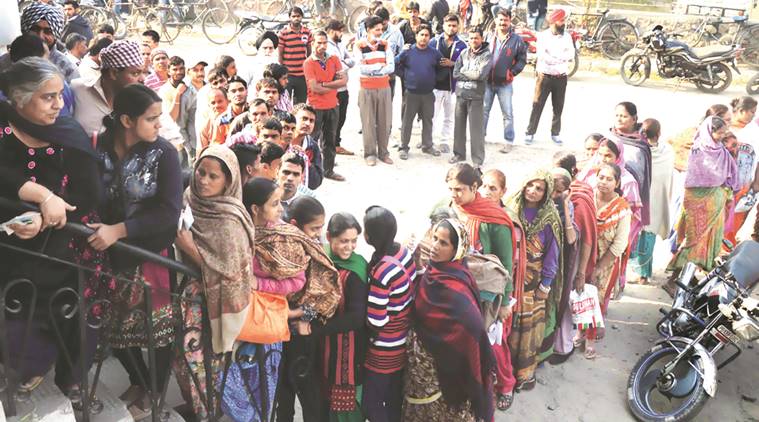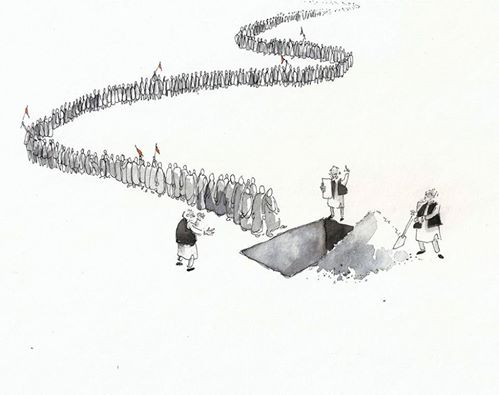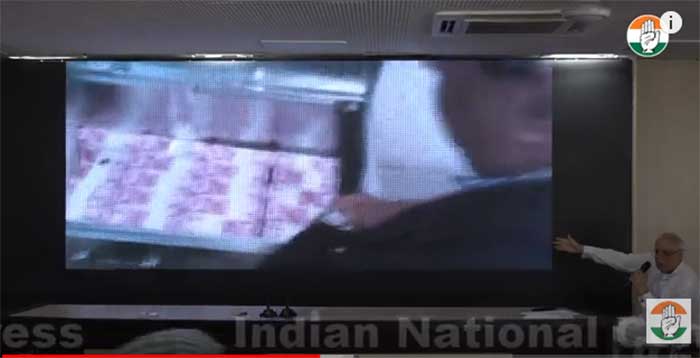
A Cashless, Corruption-free, Cow-friendly India that also Cares for the Poor. As the Narendra Modi regime shoots forth silken promises like buttered popcorn from a hot oven – it is time to remember India’s long history of using colourful fiction to rip-off the public and carry out caste oppression.
Let me explain. For over a millennium one of the recurring debates among Indian philosophers was whether this world was real or a mere dream. To be more precise,the claim was, we are all part of Maha Vishnu’s dream[1] as He sleeps peacefully on a giant serpent, with a lotus blooming from His navel.
Paradoxically though, those who preached most passionately that our senses mislead us and everything around was Maya or an illusion, went on to corner the largest chunk of material reality. Behind the smokescreen of clever mythology, it was they, who grabbed the lion’s share of everything tangible over the centuries – from land, water, natural resources to hard political and social power.
Worse still, using a mix of brute force and religious mumbo-jumbo, they consolidated the exploitation of those who shed sweat, blood and tears and work with physical reality by those who merely cook up tall stories, through the nightmare of the caste system.
The more sophisticated proponents of the ‘dream’ theory explained that it is under the spell of Maya, that the Atman or individual soul, fails to recognise we are all part of the unchanging divine principle, called the Brahman, that underlies the entire Universe. Maya they said could be dispelled only through jnana or knowledge to attain Moksha i.e. liberation- all this of course at a price to be paid to the ‘experts’, who ran the system (read fintech consultants).
Today, as the lotus sprouts once more across the land and the ruling regime promises Moksha to the masses, provided they get ‘jnana’ and go digital, Maya is back at work. And once again, it is again the castes and communities at the bottom of the Indian social ladder who are being hit the hardest.
From all evidence so far it is clear, that the Scheduled Castes and Tribes, who make up a bulk of those surviving off India’s vast informal economy, are the worst affected by the sudden disappearance of cash from the economy. Agricultural labour, construction workers, employees of micro-enterprises, the urban and rural poor – mostly from these marginalized castes- have been pushed to the brink of starvation or worse due to loss of jobs and income.
The other sections, whose lives have been severely disrupted are small and medium sized farmers, who are overwhelmingly from Other Backward Castes and artisans, mostly from poorer Muslim communities. While it is true that demonetisation has also hit the economically and caste-wise better off trading communities, it seems they are pawns to be sacrificed in the quest for complete domination by disembodied global and national corporations – our new feudal masters.
At its core the theoretical basis of the caste system, is that the mind and its creations are noble and permanent while the body is impure and ephemeral. Mental work is superior and those with the ‘right knowledge’ deserve a much greater share of all resources and a regular ‘dakshina’ or ‘transaction fee’ (think Paytm) from those who perform ‘inferior’ physical work.
(As not just India, but the entire world, sinks inexorably into the seductive web of dreams spun by digital finance and virtual technologies, it is worth examining if there is a caste system emerging globally. With software of all kinds on top and hardware, especially agriculture right at the bottom)
Just to make sure nobody misunderstood this point, the Purusha Sukta, a hymn from the ancient Rig Veda, used the analogy of the human body to describe the hierarchy clearly. The Brahmin priest/philosopher is the mouth, the Kshatriya or warrior the arms, the Vaishya or businessman the thighs and the Shudra or worker is right below as the feet. Those who have to deal with human or animal wastes are much worse off, relegated outside the pale of the caste system itself and rendered ‘untouchable’.
For centuries, and even now, this rigid division of ‘duties’, enforced often through raw violence, has been used to ensure the free transfer of energy and resources from those below to the ones at the top in various ways. The Indian caste system defies not just all laws of humanity but also of modern physics – the Second Law of Thermodynamics in particular- making it the only working model of a ‘perpetual motion’ machine on our planet!
In more recent times and through the colonial period, traditional caste privileges and inherited wealth were combined with access to modern education, to create the Indian ruling elite – family-run industrial empires, big landholders and a bureaucrat/politician nexus that today have a complete stranglehold on state power. There is also a sizeable Indian middle class serving the system, that claims its prosperity is due to a mix of merit (ability to pass exams), hard work (long hours in the office) and honesty (taxes deducted at source).
Together, all these sections of Indian society, have made best use of new opportunities thrown up by globalization in recent decades, to establish a society which is easily among the most unequal ones in the entire world. Just 1% of the richest Indians control over 58.4% of the country’s wealth[2] while the top 10% account for 80.7%. The bottom 50% of the population fights for its share of a mere 2.1%.
The Modi regime’s current campaign against corruption does not even begin to address the structural bias of the social and economic system in favour of those who have been long-term beneficiaries of illegality and immorality in different forms. Instead, it uses racist tropes to describe ill-gotten money, positing white with ‘good’ and black with ‘evil’. One Modi cabinet minister even calling the anti-corruption campaign a war on ‘asuras’ – the dark skinned indigenous people who were conquered by upper caste migrant populations in ancient India[3] and commonly figure in Hindu mythology as ‘demons’[4].
Of course, caste discrimination was acknowledged at the time of Indian independence from British colonial rule, thanks to numerous struggles by the oppressed castes. This was reflected in affirmative action policies of reserving a certain percentage of government jobs and admission to educational institutions, as also financial support through loans and special schemes, for these castes.
However, all these measures have been so half-heartedly implemented and woefully inadequate that seven decades later there is not a single positive indicator of social development where the Scheduled Castes or Scheduled Tribes figure anywhere near the top. Whether it is land holdings, income, literacy, nutrition or health status it is these sections- who constitute one-third of India’s population –that are right at the bottom of the pile.
For example, according to the Socio-Economic and Caste Census of 2011, 54% of those from the Schedule Castes were landless, while Scheduled Tribes –despite somewhat better land ownership were even more deprived due to lack of cash income[5]. Together these two communities form the most vulnerable section of India’s population.Fewer than five per cent of their households have a main earner who makes more than Rs 10,000 per month – while from other Hindu communities there are twice as many households.
Economic vulnerability is reflected in the dire health status of these populations too. In 2015 India recorded the largest number of under-5 deaths in the world, at 1·3 million[6] – most of them children from Scheduled Caste and Scheduled Tribe families. Infant mortality rates are 66.4per 1000 among Scheduled Castes, 62.1 among Scheduled Tribes, compared to 36 per 1000 for the rest of the population[7]. Again among these populations, more than 50% of the people have a body mass index below 18.5, which is regarded as chronic sub-nutrition[8] – placing them by World Health Organization standards – in a permanent state of famine.
Today, on top of all this, without functional literacy, technological skills or access to basic infrastructure, these communities are being subjected to a test in digital dexterity impossible for them to get through any time soon.
Think about it like this. If someone denied Albert Einstein his daily meal because he could not prove his mettle by playing cricket or made Sachin Tendulkar homeless for failing a quiz on quantum physics they would immediately be denounced as being either mad or extremely evil.
And yet that is exactly what the Narendra Modi dispensation is doing through its devious insistence on a digitalised economy – imposing on the already disadvantaged a test designed to not just make them fail but also put the blame for their misery on their own ‘ignorance’. If in the past they were actively denied knowledge of the ‘Vedas’ by the upper castes now,as they are trying to catch up, the rules of the game are either being changed abruptly or they are being priced out of the market.
The most apt way to describe what is happening in India today is perhaps through a completely new term –dwijitalisation. It captures well the long-term implications of Narendra Modi’s push for a digital economy in a country that has long been ruled by the dwij – or twice born castes as the Hindu elite call themselves. Under the new rules of the dwijital economy only the dwij– at the top of the social, economic and political ladder – will climb still higher, while kicking the ladder down to ensure no one can follow.
If there is to be a fightback against such injustice there are three cardinal lessons to be learnt from the history of the Indian caste system and religious myth making. One is that the most blatant of lies backed by force is always mightier than the weightiest fact – in other words, when the rulers claim to have a ‘democratic dialogue’ with the people, they are in fact deploying an iron fist in a velvet glove.
Second – what really matters at any point of time is who controls things that can be touched and felt – everything else is poppycock. Meaning – ignore their mantras and follow the moolah – are you getting any of it or not?
The third and most critical lesson to pay attention to is – STOP ARGUING, START ORGANIZING!
Satya Sagar is a journalist and public health worker who can be reached at [email protected]
[1] http://www.hinduwisdom.info/articles_hinduism/12.htm
[2] http://www.livemint.com/Money/MML9OZRwaACyEhLzUNImnO/The-richest-1-of-Indians-now-own-584-of-wealth.html
[3] http://www.thehindu.com/news/national/It-was-an-attack-on-four-%E2%80%98asuras%E2%80%99-Parrikar/article16668448.ece
[4] https://www.britannica.com/topic/asura
[5] http://indianexpress.com/article/india/india-others/landlessness-is-higher-among-dalits-but-more-adivasis-are-deprived/
[6]Global, regional, national, and selected subnational levels of stillbirths, neonatal, infant, and under-5 mortality, 1980–2015: a systematic analysis for the Global Burden of Disease Study 2015; GBD 2015 Child Mortality Collaborators; www.thelancet.com Vol 388 October 8, 2016
[7] http://tribal.nic.in/WriteReadData/userfiles/file/ScheduledTribesData/Section3.pdf
[8] http://www.governancenow.com/views/interview/india-facing-stable-famine-situation















































